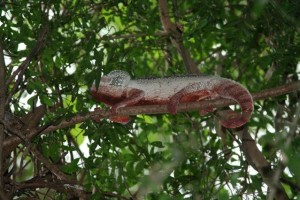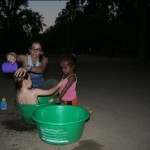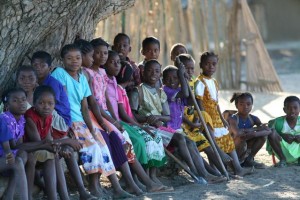…today we present part two of Jason Albert’s the Big Red Island…
Outdoor school began.
Draped above our tent was an old-growth Tamarind tree. Sporadically we heard jostling in the limbs above. Unzipping the tent, my son gawked up. A group of six sifaka, a striking lemur species with thick white hair and contrasting black face, busied about. My wife and I made loud “shoosh” gestures to prevent our son from scaring them off. He stared up. He simply observed. Our son is prone to fast movements, loud noises, and general un-calmness. But like a seasoned naturalist, he kept quiet. His eyes tracked the sifaka’s movements. Their leaping prompted barely audible giggles. Sunlight filtered through the canopy and dappled our tent. This was a child’s dream and a gift to parents. Despite the inherent physical and emotional risks here, we realized we were on to something.
Days later outside our shaded tent, as we escaped the intense 110° heat, my son spotted a well-camouflaged chameleon. I had been staring in the direction of the chameleon but could see only foliage: my mind cluttered with decades of modern cacophony. On our daily hikes into the dry deciduous and spiny forests endemic to this region, my son’s were the keen eyes. His vision unfiltered with nonsense. He’d spot ring-tailed lemurs in a tangle of lofty tree branches. He rode behind me in my backpack and would prod my cheek to make me turn and study a sifaka group clinging to tree trunks perched at eye level. I would have sauntered by, head down and unaware. The sifaka were still, watching my son watch them. I would have to learn to be measured; un-train my sense of time urgency. Otherwise, the surrounding theater would be inaccessible.
The chameleon painted itself a baby-powder white with small black splotches. My son inched within a meter. Its didactyl feet grasped a branch. Its head moved methodically. Its eyes, able to rotate and focus independent of one another, provided a mesmerizing display. Thrilled, my son sat and focused.
The day we observed the chameleon my transformation from teacher to student began. In the slowing of our daily lives, my son served as my guide. Unbeknownst to him, he assumed the role of teacher. I know now, that without his presence, my experience in Madagascar would have rendered me slightly more enlightened adult with a hard drive thick with “look at me” photo ops. Instead, my son prepared me to embrace our humanness and actually see a world. This is the lovely beauty of traveling with children.
My son embraced the chameleon life. Any opportunity to observe chameleons was met with fast feet to locate them. And too, these creatures became the vehicle for role-play. I had once imagined that my children would run in slow motion, a mechanical sound thumping in the background, as they mimicked the Six-Million-Dollar Man — game my older brother and I embraced. Environment begets play and without reruns of 1970’s television shows my son turned to the natural world. My son would get on all fours, move his limbs bit by bit, as if frame-by-frame. His head cocked molasses-like side to side. His tiny tongue poked out as if he could taste the ether.
~~
Three small villages were within four-kilometers from our tent site. Word spread fast that a small American boy had arrived. Herds of kids walked to our site and just as my son was learning to examine the natural world, he became the subject of focused inquiry. The sight of a sun-lotion-lathered primate specialist in this region was humdrum. For years, Banana Republic clad researchers had sported GPS, night vision scopes, a technical vernacular for all things primate, and a legacy of good intentions in this region. As proof, two picked-apart anachronistic World Wildlife Fund Land Cruisers sat helpless, propped up on cinder blocks awaiting a better fate. Now and then, a mechanic from afar would motor in on a high-pitched motorbike; wrench off a needed part and be gone.
But once a diaper clad English speaking toddler arrived, the game was on. On hot, listless days, barefoot kids with patchwork clothes stared intently, feet away from my son just picking away in the dirt. If my son moved, they moved. Curiously, gestures to communicate were not offered. In my best attempts, I conveyed the message of his novelty to him. To this day, four years later, when we are viewing photographs, I am unsure still if he even perceives himself as different from those we left behind.
Despite the fame he engendered, only one small girl befriended him. This girl, named Samsea, was roughly the same age. Through her we all learned the folly of packing a potty, too many toys, and most of our son’s clothing. These two friends played simple games with a pile of dirt. They ran around despite sweltering heat. They fought and laughed. They ate snacks together. Like many children in this part of the world, a child’s daily caloric intake is a fraction of most American kids. Samsea was no outlier. Her slightly distended belly a vivid reminder. Daily, the three of us would sit in the shade and choose snacks. My child ate little, as is typical of him. Samsea devoured the food. She usually ate both servings. Be it cheese, crackers, chocolate, or cookies; she seemed eternally hungry.
Unaware of my son’s developing cultural bias, Samsea began prodding my son in a mixture of toddler Malagasy-English to dump the diapers and sport underwear. People in this region of Madagascar, the dry Southwest forest, believe buried ancestors render the soil sacred. People defecate at ground level. This habit prevents denigrating the resting place of the dead. Perhaps I am old school and perfunctory: or perhaps for sanitary purposes I used the pit toilet. My son had no bias. He watched Samsea drop her underwear and make her business. It did not take long for my son to imitate. Although accidents occurre d, this little girl further exposed our foolishness. The port-o-potty, flown nearly as far from our home as geographically possible, including Antarctica, proved its worthlessness. I cannot recall what occurred to the potty. For a time, it sat next to our tent: the sun fading its brittle plastic.
d, this little girl further exposed our foolishness. The port-o-potty, flown nearly as far from our home as geographically possible, including Antarctica, proved its worthlessness. I cannot recall what occurred to the potty. For a time, it sat next to our tent: the sun fading its brittle plastic.
Stay tuned for Friday’s conclusion.


fascinating. absolutely love it — thanks. love the switched roles (teacher-student), how alien the landscape and wildlife seem to our prevailing notions, and the whole thing about the kids and your son — wow. can’t wait for fri.